iCloud Drive to FTP: Practical Ways to Transfer Your Files in 2025
Need to push files from iCloud Drive to an FTP server? This updated 2025 guide covers four distinct workflows—from simple Finder moves to cloud-based automation—so you can get it done without bottlenecking your internet.
Introduction
Apple’s iCloud Drive is great for personal storage, but sometimes your work demands an old-school FTP upload—maybe for a company web host, a media archive, or a client’s server. The tricky part? Moving files between these two worlds efficiently. In this guide, I’ll walk you through four ways to make it happen: using Finder with FTP clients, web-based cloud managers, lightweight terminal commands, and automated sync setups. Each method has its own strengths, so you can choose what feels right for your workflow.
iCloud Drive is Apple’s built-in cloud storage system, designed for smooth integration with macOS, iOS, and even Windows devices. Every Apple ID includes 5 GB of free storage, with the option to expand to up to 12 TB via iCloud+.
- Device-wide sync: Your Mac’s Desktop and Documents folders are mirrored across iPhone, iPad, and the iCloud web interface.
- Handles large uploads: Store single files as big as 50 GB—ideal for high-res creative projects.
- Accessible anywhere: Open iCloud Drive in Finder (Mac), Files app (iOS), File Explorer (Windows), or any modern web browser.
- Collaboration features: Share files or folders, manage permissions, and co-edit documents in real time.
- Security-first design: End-to-end encryption and optional Advanced Data Protection safeguard your files across Apple’s ecosystem.
File Transfer Protocol (FTP) is a long-standing standard for moving files between computers over a network. While it’s been around since the early days of the internet, FTP is still used today for website management, server backups, and bulk data transfers.
- Platform-agnostic: Works on Windows, macOS, Linux, and even directly from mobile devices with the right client app.
- Multiple access modes: Supports standard FTP, FTPS (SSL/TLS encryption), and SFTP (over SSH) for enhanced security.
- Efficient for large uploads: Capable of handling big file transfers without the sync delays common in some cloud services.
- Wide tool support: Connect using software like FileZilla, Cyberduck, or even command-line utilities like lftp.
- Direct server control: Ideal for managing website files, uploading backups, or accessing private company servers without a third-party intermediary.
While iCloud Drive works beautifully inside the Apple ecosystem, there are plenty of scenarios where you’ll need to push files to an FTP server instead—such as updating a website, sharing large datasets with a remote team, or archiving backups directly to a private host. FTP remains a widely supported protocol across industries, making it a practical choice when you want direct control over where and how your files are stored.
- Universal Access: FTP works across macOS, Windows, Linux, and even mobile platforms, ensuring you can upload and retrieve files from virtually anywhere with an internet connection.
- Customizable File Retention: Many FTP servers allow you to manage your own storage lifecycle—archiving, rotating, or deleting files as needed without relying on a third-party’s retention policies.
- Multi-User Management: Set up different user accounts with specific permissions, perfect for collaborative projects where each team member needs tailored access.
- Flexible Storage Handling: You can store massive files—well beyond typical cloud storage limits—without syncing delays. With tools like FileZilla or Cyberduck, you can browse and transfer files seamlessly.
- Enhanced Security Options: Beyond standard FTP, secure variants like FTPS and SFTP add encryption to protect your data in transit—vital for sensitive information.
- Cost Control: Many hosting providers include FTP access with their plans at no extra cost, and self-hosted FTP solutions can be run entirely in-house for minimal ongoing expense. Compare hosting options here.
- Integration with Automation Tools: FTP can be scripted via command-line utilities like lftp or integrated into CI/CD pipelines for continuous deployment and backups.
Whether you’re moving away from iCloud for direct server access, need more flexible file management, or want to maintain control over your own infrastructure, FTP remains a dependable option. Its protocol flexibility, tool support, and independence from proprietary ecosystems make it a solid choice for long-term storage and workflow integration.
Before you decide to move files from iCloud Drive to an FTP server, it’s worth understanding how these two differ in terms of storage management, accessibility, and workflow. While iCloud Drive is a polished, cloud-based service tied closely to Apple’s ecosystem, FTP is an open protocol that gives you direct control over where and how your data is stored.
| Feature | iCloud Drive | FTP |
|---|---|---|
| Free Storage | 5 GB included with Apple ID | Depends on hosting provider or self-hosted server capacity |
| Platform Integration | Native to macOS, iOS; available on Windows via iCloud for Windows | Works on virtually any OS—macOS, Windows, Linux, and mobile via client apps like FileZilla |
| Collaboration Capabilities | Real-time collaboration mainly within Apple apps (Pages, Numbers, Keynote) | Multi-user access with configurable permissions; ideal for teams managing shared server directories |
| Third-Party Integration | Mostly limited to Apple services and a few supported apps | Integrates with CMS platforms, CI/CD pipelines, and automation scripts via tools like lftp or wget |
| File Versioning & Recovery | Version history varies by app and plan; some recovery options available | No built-in versioning; retention and backup handled manually or via server-side scripts |
| Security | End-to-end encryption with optional Advanced Data Protection | Depends on configuration—use FTPS or SFTP for encryption, plus server-level access control |
In short, iCloud Drive is ideal if you’re fully embedded in Apple’s ecosystem and want a “set-it-and-forget-it” sync experience. FTP, on the other hand, is better suited when you need maximum flexibility, large-file handling, or direct server access for projects like website deployment, backups, and private data archives.
Before you start moving files from iCloud Drive to an FTP server, it’s worth taking a moment to review your storage and file organization. Check how much space your current iCloud Drive is using and what file types are included—this will help you decide if your FTP host or server has the capacity and bandwidth to handle the transfer.
If you don’t yet have FTP access set up, you’ll need login credentials from your hosting provider or network administrator. These typically include a server address, username, password, and sometimes a specific port number. Many providers offer secure transfer methods like FTPS or SFTP, which encrypt your connection for added security.
It’s also a smart move to tidy up your iCloud Drive folders before migrating. Removing unnecessary files and grouping related documents into clearly named directories will make the upload process smoother—especially if you plan to use tools like FileZilla or Cyberduck, which allow you to drag entire folders directly to your FTP destination while keeping the structure intact.
Finally, double-check your internet connection if you’ll be uploading from your local machine, or consider a cloud-to-cloud transfer service like MultCloud to bypass local bandwidth limits. Having your credentials, storage space, and folder layout ready in advance will make your iCloud-to-FTP transfer far more efficient.
Method 1: Transfer via Web Browsers
Step 1: Download Files from iCloud Drive
Begin by opening the official
iCloud Drive
web interface
and signing in with your Apple ID. Once inside, locate the folders or files you plan to transfer.
To select multiple items, hold the Command key on macOS or Ctrl on
Windows.
Use the download icon (a cloud with a downward arrow) from the top menu to save your selections. If you download a full folder, iCloud will package it into a ZIP file. After downloading, unzip the file locally so the individual contents are ready for uploading to your FTP server.
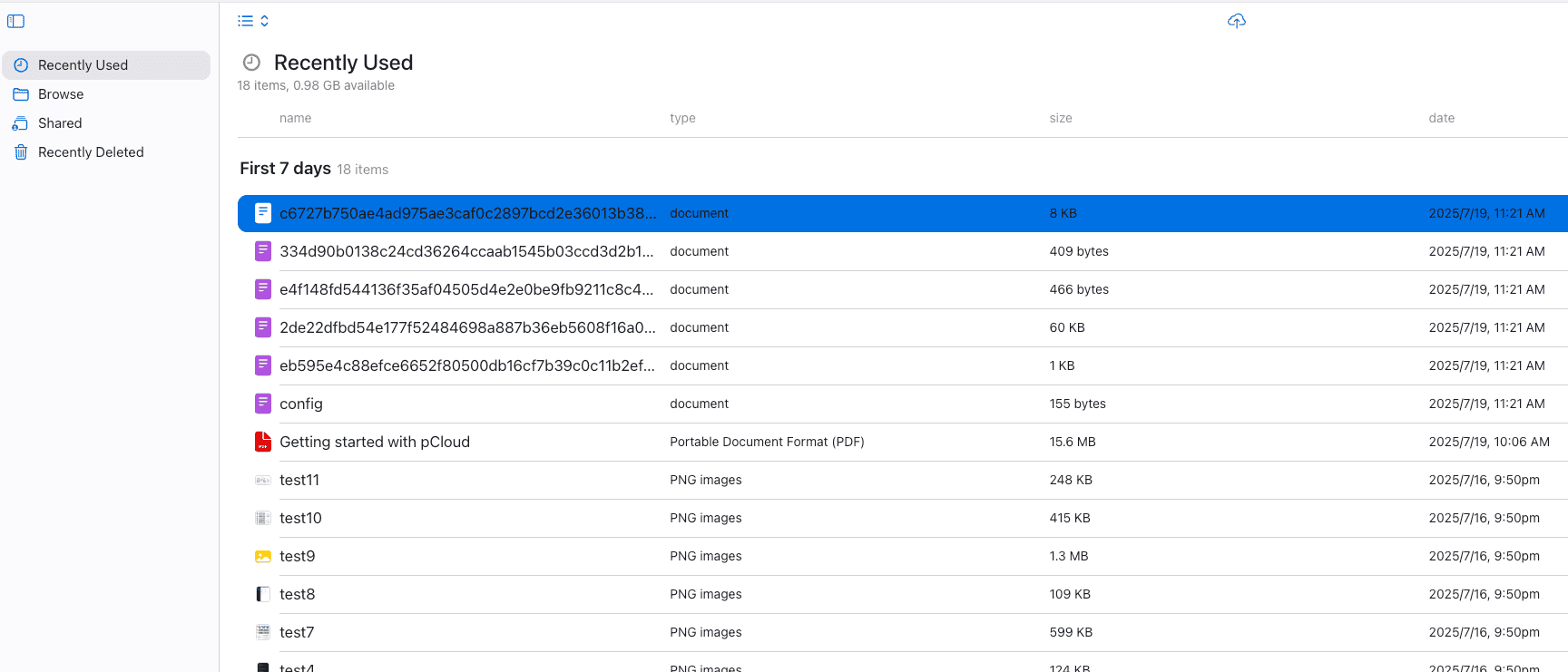
Step 2: Upload Files to Your FTP Server
Most hosting providers and server setups allow you to upload files via a web-based file manager, often found in control panels like cPanel or DirectAdmin. Log in to your hosting account, open the file manager, and navigate to the target directory on your FTP server.
From here, you can either click the "Upload" button and select your files, or drag-and-drop them directly into the browser window if your control panel supports it. If you previously unzipped an iCloud folder, it’s a good idea to recreate the same folder structure on your FTP server to maintain organization.
This browser-based method works well for occasional uploads or smaller file sets. However, for larger projects or more complex folder trees, web uploads can be slow or prone to timeouts. In such cases, using a desktop FTP client like FileZilla or Cyberduck, or a cloud-to-cloud transfer service, may be more efficient and reliable.
Method 2: Command-Line Transfer with Rclone
Step 1: Install Rclone and Configure iCloud & FTP Remotes
If you’re comfortable with the command line and want maximum control over your transfers, Rclone is one of the most versatile open-source file transfer tools available. It supports direct connections to iCloud Drive and a variety of protocols—including FTP, FTPS, and SFTP.
Download the latest release from the
Rclone downloads
page
and install it for your operating system. Once installed, open your terminal or command prompt and run:
rclone config to start creating your remote configurations.
- Option 1 – iCloud via Local Path: On macOS, iCloud Drive files are stored in
~/Library/Mobile Documents/com~apple~CloudDocs, which you can point Rclone to directly. - Option 2 – iCloud as a Remote Backend: Rclone now has native support for iCloud
Drive.
When running
rclone config, chooseicloudas the storage type. This method allows access without a fully synced local copy. See the official backend documentation for authentication and API token setup. - FTP Remote: For FTP, choose
ftpas the storage type and enter your server address, username, and password. You can also opt for FTPS or SFTP if your server supports encryption.
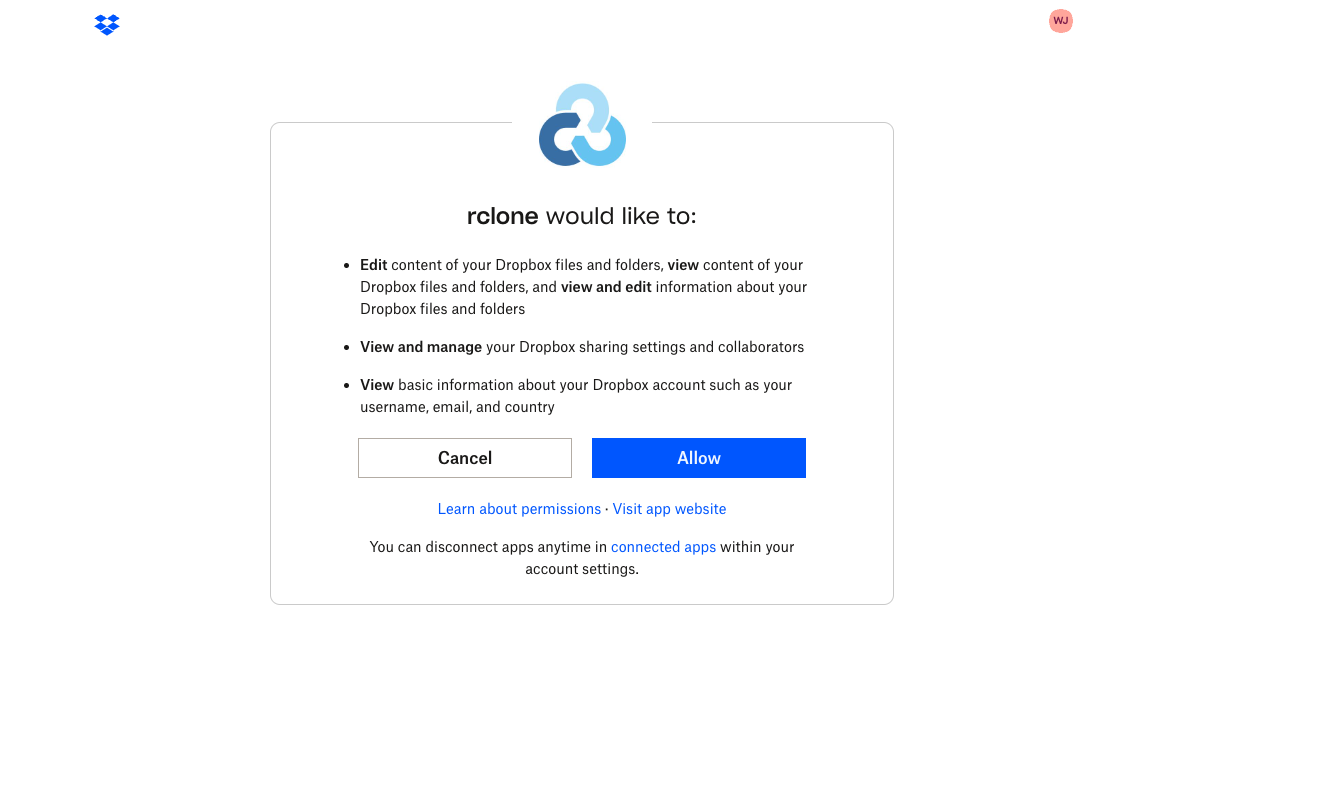
Step 2: Run the Transfer
After both remotes are set up, you can start transferring files from iCloud Drive to your FTP server. Here are two common examples:
rclone copy "~/Library/Mobile Documents/com~apple~CloudDocs" ftp:/public_html/iCloudBackup --progressrclone copy icloud:/Documents ftp:/backups/iCloudDocs --progress
In these commands, files from your iCloud Drive—whether accessed locally or as a remote backend—are
copied into
the specified directory on your FTP server. You can test the transfer first with --dry-run
or
exclude unnecessary files with --exclude.
Rclone is ideal for advanced users who want to automate iCloud-to-FTP transfers, integrate them into scripts, or run scheduled jobs via cron (Linux/macOS) or Task Scheduler (Windows). With features like bandwidth throttling, file filtering, and checksum verification, it’s one of the most reliable ways to handle large-scale migrations—just be sure to follow the backend documentation closely, especially for iCloud authentication and token management.
Method Three: Direct Cloud-to-Cloud Transfer with Cloudslinker
Overview: Moving iCloud Drive Files to FTP Without Local Downloads
Cloudslinker allows you to transfer data directly between cloud services and servers—no downloading to your computer, no re-uploading, and zero local storage consumption. It supports over 40+ platforms, including iCloud Drive and standard FTP, as well as secure protocols like FTPS and SFTP. Transfers run entirely in the cloud, so your internet speed is never a bottleneck.
Step 1: Log In to Cloudslinker
Visit app.cloudslinker.com
and sign in. New users can register for free. On the dashboard, click "Add Cloud"
from the left menu.
Start by adding your FTP server—you’ll need the Host,
Username, and
Password. If your account only has access to a subdirectory, fill in the
Access Path
to specify it; otherwise, Cloudslinker will default to the root directory.

You can choose standard FTP or opt for encrypted transfers using FTPS/SFTP, depending on your server’s capabilities. Many hosting providers list these settings in their control panel documentation.
Step 2: Link iCloud Drive
Select iCloud Drive from the cloud list. Enter your Apple ID credentials when prompted. If you have two-factor authentication enabled, verify using the code sent to your Apple device. Once confirmed, your iCloud Drive will appear in your Cloudslinker connections.
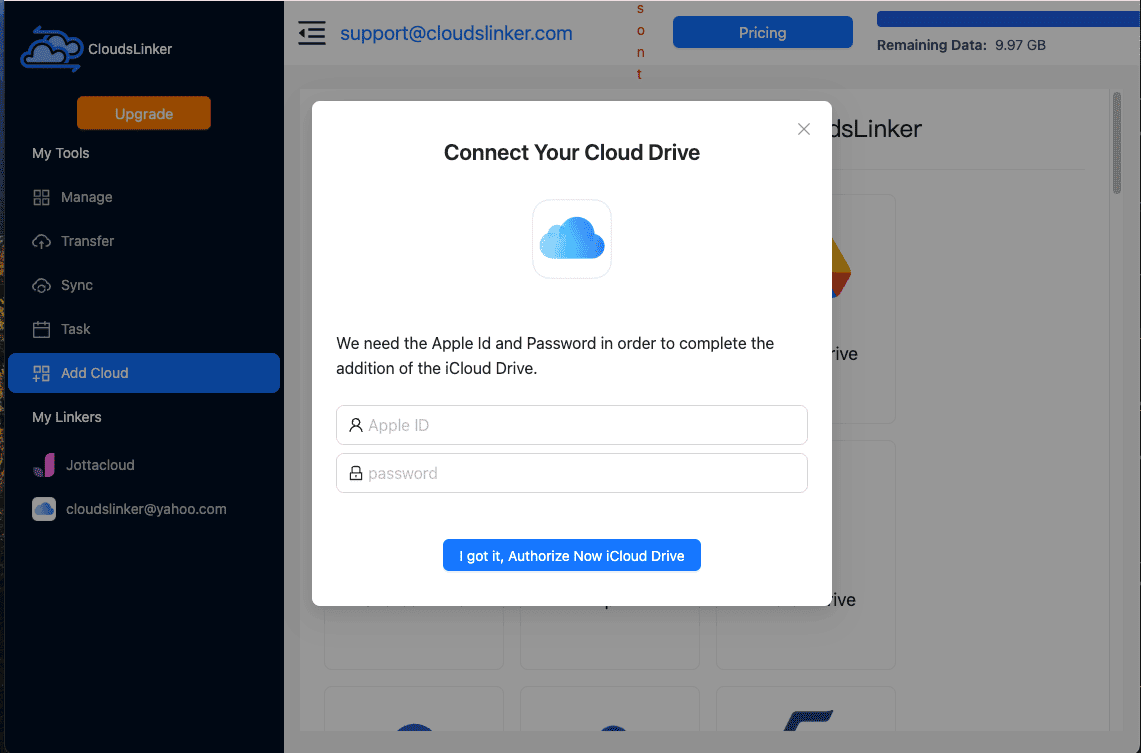
Step 3: Set Up the Transfer
Open the Transfer tab and set iCloud Drive as the source. Select the files or folders to move, then choose your FTP connection as the destination. You can preview both sides’ directory structures before proceeding to ensure everything matches your plan.

Use advanced filters to skip hidden files like .DS_Store, exclude large media files, or
only
transfer items modified in a specific date range. This is especially useful when syncing work
directories
or maintaining a clean server structure.
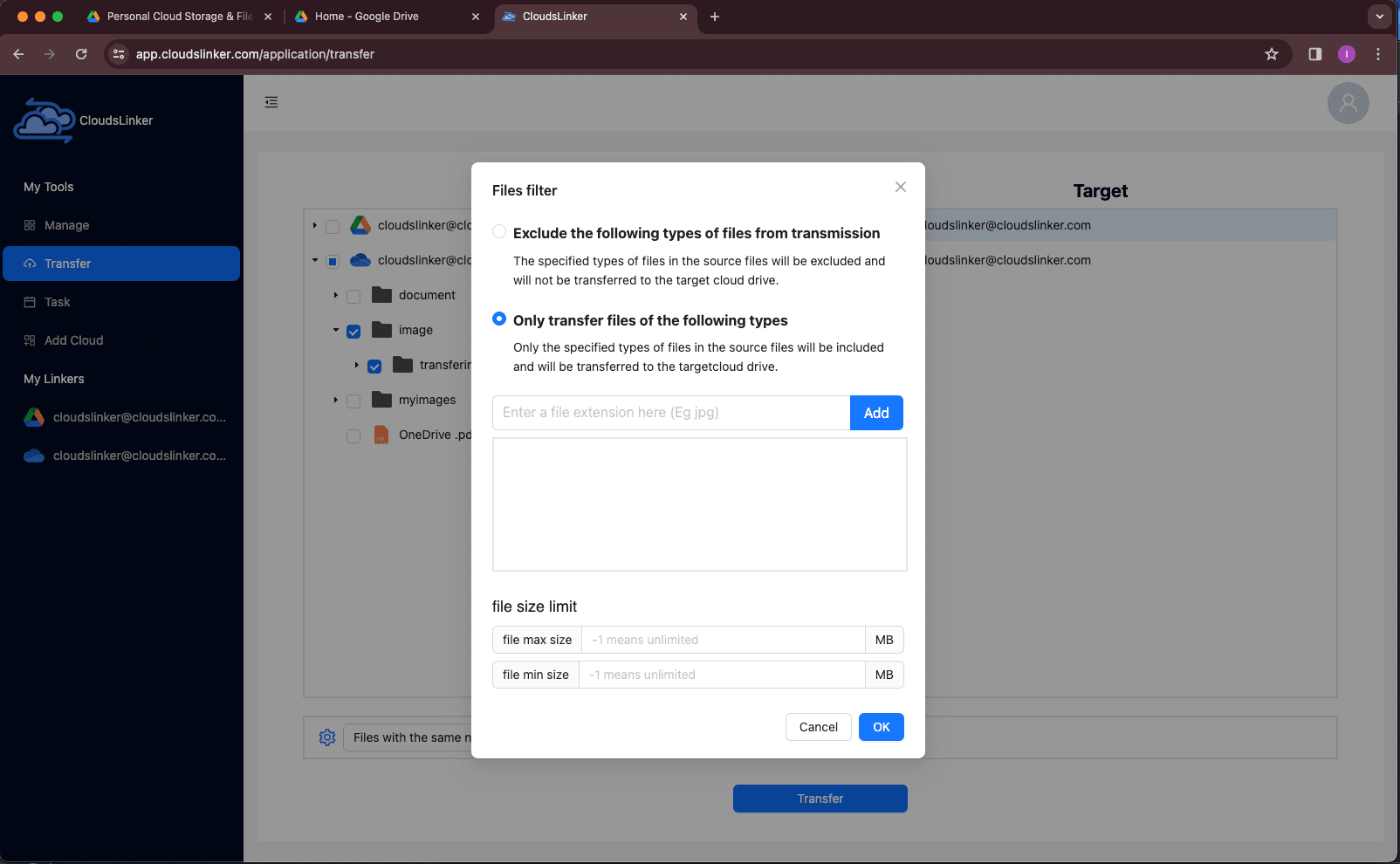
Need regular synchronization between iCloud and your FTP? The Schedule feature allows you to set daily, weekly, or hourly jobs. Once scheduled, these transfers happen automatically in the background without your intervention.
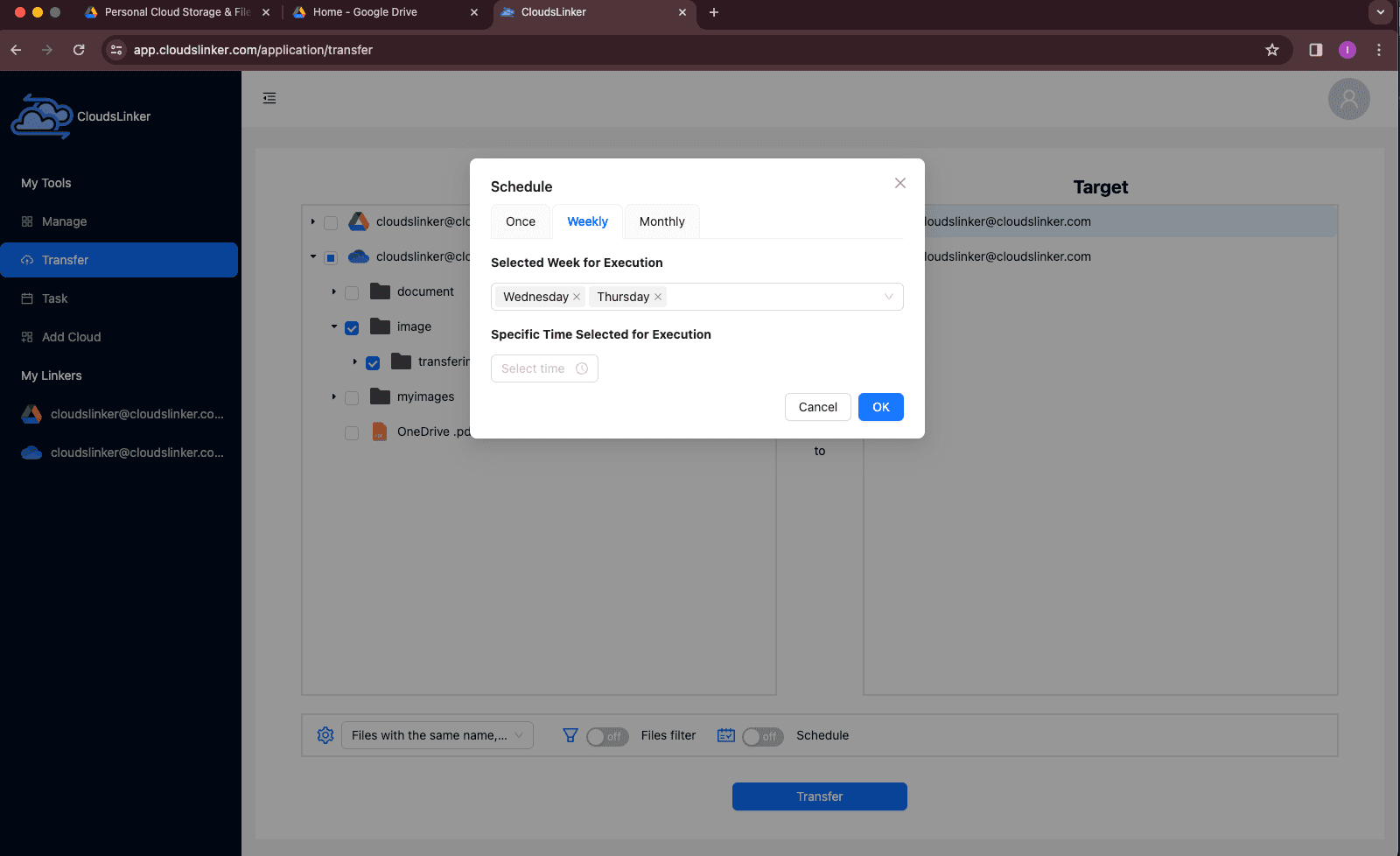
Step 4: Monitor the Transfer
Once the task starts, you can track progress in the Task List. The interface shows current speed, estimated time, and file counts. You can pause, resume, or restart tasks as needed. Any files that fail—due to permissions or unsupported formats—will be flagged for review.
Step 5: Review Completion Logs
After completion, Cloudslinker generates a detailed summary of the transfer, including success and error logs. Your selected iCloud Drive files will now be securely stored on your FTP server, ready for use.
For those seeking a fast, reliable, and entirely hands-off way to migrate from iCloud Drive to FTP, Cloudslinker offers a perfect blend of simplicity and advanced control—making it ideal for both personal and professional use.
Need to Transfer Between Other Cloud or Server Types?
From Google Drive and MEGA to WebDAV and S3-compatible storage, Cloudslinker supports direct migrations without consuming your local bandwidth. Check the full platform list to see all supported services.
Comparing the 3 Ways to Transfer from iCloud Drive to FTP
There isn’t a single “best” way to move files from iCloud Drive to an FTP server. The right method depends on how much data you’re moving, how often you’ll do it, and how comfortable you are with different tools. Below is a side-by-side comparison of the three main approaches we’ve covered—so you can decide which one fits your workflow and priorities best:
| Method | Ease of Use | Speed | Best Suited For | Uses Local Bandwidth | Skill Level |
|---|---|---|---|---|---|
| Web Browser + FTP File Manager | ★★★★★ | ★★★☆☆ | Small, occasional transfers via cPanel/DirectAdmin | Yes | Beginner |
| Rclone (Command-Line) | ★★☆☆☆ | ★★★★★ | Power users, automation, large-scale backups | Yes / No (if using remote iCloud backend) | Advanced |
| Cloudslinker (Cloud-Based) | ★★★★★ | ★★★★★ | Bulk transfers, recurring syncs, zero local impact | No | Beginner |
If you only need to move a handful of files now and then, using a browser-based FTP file manager (such as the one in cPanel or DirectAdmin) will be quick and straightforward. Technical users who want automation and advanced control should consider Rclone, which can run scheduled syncs, apply filters, and handle large datasets efficiently. But if you’re looking for the easiest and most bandwidth-friendly method—especially for heavy migrations or ongoing sync—Cloudslinker stands out. Because transfers happen entirely in the cloud, your computer can be turned off and your internet speed won’t slow the process.
Moving files from iCloud Drive to an FTP server is usually straightforward, but a few best practices can help you avoid slowdowns or errors—especially when dealing with large data sets or mixed file types:
- Ensure Files Are Fully Downloaded (if local transfer): If you’re using Finder or a local sync before uploading via an FTP client like FileZilla, confirm that your iCloud files are stored locally—not just as placeholders. Incomplete files won’t upload properly.
-
Check FTP Storage Limits:
Most self-hosted FTP servers have space defined by your hosting plan or physical disk size.
Verify available capacity via your control panel or by running a
df -hcommand on Linux. - Mind Bandwidth Constraints: Local uploads depend on your internet speed. If your connection is slow, consider using a cloud transfer service like Cloudslinker that sends data server-to-server without consuming local bandwidth.
- Use the Right Protocol: If you’re handling sensitive files, opt for FTPS or SFTP instead of plain FTP for encrypted transfers.
- Secure Your Credentials: Avoid storing plain-text passwords in scripts or config files. Use encrypted password storage or key-based authentication when available.
- Plan for Large Migrations: For hundreds of gigabytes, use tools that support resume and error recovery (e.g., Rclone or Cloudslinker). This ensures the process can restart without re-uploading completed files.
A bit of preparation—checking storage, securing logins, and deciding on the right protocol—will make your iCloud to FTP migration faster, safer, and less prone to interruptions.
Frequently Asked Questions
Watch Our Step-by-Step Video Tutorial
Follow our detailed walkthrough to transfer files from iCloud Drive to an FTP server. Learn practical tips, avoid common pitfalls, and see both manual and automated methods in action. Perfect for first-time FTP users or those looking for a faster, more secure transfer process.
Conclusion
Shifting files from iCloud Drive to FTP doesn’t have to be complicated. If you’re in a hurry, a drag-and-drop FTP client like Cyberduck or Transmit will do the job without extra setup. For those managing larger transfers or repeated uploads, a cloud connector like removes the need to download anything locally. Command-line tools and scripted syncs give power users complete control. However you approach it, the key is to match the tool to your transfer size, security needs, and comfort level—so your files arrive exactly where they should, without wasted time.
Online Storage Services Supported by CloudsLinker
Transfer data between over 45 cloud services with CloudsLinker
Didn' t find your cloud service? Be free to contact: [email protected]
Further Reading
Effortless FTP connect to google drive: Transfer Files in 3 Easy Ways
Learn More >
Google Photos to OneDrive: 3 Innovative Transfer Strategies
Learn More >
Google Photos to Proton Drive: 3 Effective Transfer Techniques
Learn More >












































